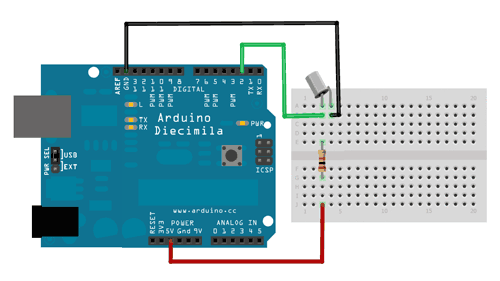
AT407 기울기 센서입니다. 안쪽의 공이 센서의 연결을 결정하며 이로써 단락이 결정됩니다. 일반 스위치 사용 방법과 비슷합니다.
관련 문서
사용 예제 기울기 센서로 다음과 같이 회로를 구성해서 기울기를 감지할 수 있습니다. 저항은 10K 저항을 풀업으로 사용하였습니다. 
아두이노 소스코드
- int inPin = 2; // the number of the input pin
- int outPin = 13; // the number of the output pin
-
- int LEDstate = HIGH; // the current state of the output pin
- int reading; // the current reading from the input pin
- int previous = LOW; // the previous reading from the input pin
-
- // the follow variables are long's because the time, measured in miliseconds,
- // will quickly become a bigger number than can be stored in an int.
- long time = 0; // the last time the output pin was toggled
- long debounce = 50; // the debounce time, increase if the output flickers
-
- void setup()
- {
- pinMode(inPin, INPUT);
- digitalWrite(inPin, HIGH); // turn on the built in pull-up resistor
- pinMode(outPin, OUTPUT);
- }
-
- void loop()
- {
- int switchstate;
-
- reading = digitalRead(inPin);
-
- // If the switch changed, due to bounce or pressing...
- if (reading != previous) {
- // reset the debouncing timer
- time = millis();
- }
-
- if ((millis() - time) > debounce) {
- // whatever the switch is at, its been there for a long time
- // so lets settle on it!
- switchstate = reading;
-
- // Now invert the output on the pin13 LED
- if (switchstate == HIGH)
- LEDstate = LOW;
- else
- LEDstate = HIGH;
- }
- digitalWrite(outPin, LEDstate);
-
- // Save the last reading so we keep a running tally
- previous = reading;
- }
Description: This AT407 basic tilt switch can easily be used to detect orientation. Inside the can are a pair of balls that make contact with the pins when the case is upright. Tilt the case over and the balls don’t touch, thus not making a connection. There are numerous uses for these basic sensors, but keep in mind you might need to use some debouncing code, as the sensor isn’t immune to small vibrations and such. Documents:
|